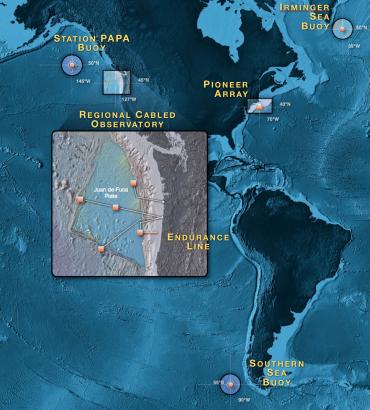Ocean Observatories Initiative
The Ocean Observatories Initiative of the National Science Foundation will launch a new era of scientific discovery in the oceans.
Spanning the Western Hemisphere
The Ocean Observatories Initiative will construct a network of instruments, undersea cables, and moorings that will span the Western Hemisphere. This network of observatories will measure physical, chemical, geological and biological phenomena in carefully selected key coastal, regional and global areas. A common computer architecture--cyberinfrastructure--will integrate the observatories'
thousands of instruments, tens of thousands of users, and terabytes of
data. Educational elements are under development with the goal of reaching a global audience.
Transformation in Ocean Research
The ocean presents major obstacles to human exploration: it is corrosive, it can exert tremendous pressures,we cannot live in it, cannot visit for long, cannot see through it very well or probe it effectively with satellites. But recent technological leaps have brought us to the brink of a sweeping transformation in our approach to ocean research. The focus on expeditionary science using ships is expanding to embrace a permanent human telepresence in the oceans. New instruments and networks permanently installed in our oceans will be able to communicate instantly with scientists on land and be able to carry out real-time user commands or complex pre-programmed instructions. The result will be long-term, continuous and real-time understanding of critical but transient ocean phenomena.
As Marcel Proust wrote:
The real voyage of discovery
consists not in seeking new landscapes,
but in having new eyes.
Cutting-edge approaches will provide the OOI with new "eyes." We will begin to "see" the interplay of
earth, ocean, and life through the lens of next-generation technology.
Contribution to Global Effort
OOI is the National Science
Foundation’s contribution to the U.S. Integrated Ocean Observing System (IOOS). While the science-driven OOI will focus on discoveries enabled
by new technologies, IOOS will concentrate on direct applications to
everyday societal needs. IOOS data will feed into the Global Ocean
Observing System, an international program with similar goals.
Planning for the OOI
The
Consortium for Ocean Leadership has been tasked by NSF to facilitate and coordinate
development of the Ocean Observatories Initiative. Ocean Leadership is a Washington, DC-based nonprofit organization that
represents 95 of the leading public and private ocean research and
education institutions, aquaria and industry with the mission to
advance research, education and sound ocean policy.
Implementing Organizations
Three Implementing Organizations have been named to support the
development, installation and initial operation of components the OOI.
The University of Washington leads the IO for the Regional Scale Nodes;
Woods Hole Oceanographic Institution leads a consortium that includes Scripps
Institution of Oceanography at the University of California, San Diego,
and Oregon State University’s College of Oceanic and Atmospheric
Sciences for the Global and Coastal Scale Nodes; the University of
California, San Diego, is leading the computer architecture or Cyberinfrastructure (CI) portion of the OOI. Scripps Institution of
Oceanography leads the project while the UCSD division of the
California Institute for Telecommunications and Information Technology
(Calit2) will manage it and, together with Scripps and the San Diego
Supercomputer Center (SDSC), will build much of the cyberinfrastructure.
Next Steps: Funding
Many years of planning and development on the part of the
oceanopgrahic science and education communities have gone into the OOI.
The next major step is the Final Design Review, which is scheduled for
November 2008. A successful review will result in a request from the
Natonal Science Foundation to the National Science Board that approximately $330
million be released to fund construction of the OOI over five years,
beginning in 2010.
























